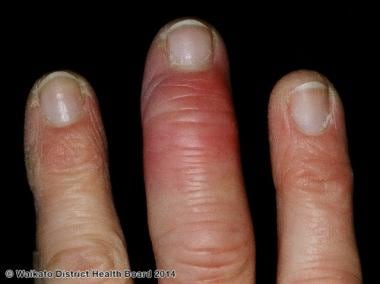Practice Essentials
Erysipeloid is an acute bacterial infection of traumatized skin and other organs. Erysipeloid is caused by the non–spore-forming, non–acid-fast, gram-positive rod microorganism, Erysipelothrix rhusiopathiae (insidiosa), which long has been known to cause animal and human infections. Direct contact between meat infected with E. rhusiopathiae and traumatized human skin results in erysipeloid. In animals, the organism causes swine erysipelas and several other diseases in poultry and sheep. [1] Additionally, a study of 18 turkey flocks in Brazil found that Erysipelothrix sp. strain 2 (ES2) behaves similarly to E. rhusiopathiae on a cellular level, raising the possibility that ES2 could also represent a risk to humans. [2]
Erysipeloid is an occupational disease. [3, 4] Humans acquire erysipeloid after direct contact with infected animals. Erysipeloid is more common among farmers, butchers, cooks, homemakers, seafood processors, and anglers. The infection is more likely to occur during the summer or early fall. See the image below.
 Erysipeloid. Courtesy of DermNet New Zealand (http://www.dermnetnz.org/topics/erysipeloid/) and the Waikato District Health Board (http://www.waikatodhb.health.nz/).
Erysipeloid. Courtesy of DermNet New Zealand (http://www.dermnetnz.org/topics/erysipeloid/) and the Waikato District Health Board (http://www.waikatodhb.health.nz/).
Presentation
Erysipeloid may present in localized, diffuse cutaneous, or systemic forms.
Causes
Erysipelothrix rhusiopathiae causes all 3 forms of erysipeloid. E. rhusiopathiae is a thin, gram-positive bacillus that may be straight or slightly curved. The microorganism is present in the soil and in poultry, fish, and birds. Homemakers, farmers, anglers, and butchers are at increased risk of acquiring the infection. In at least 2 recorded cases in the literature, the suspected zoonotic source of erysipeloid was a cat bite or scratch. [5, 6] Injection comes from a prior wound being contaminated with the bacteria.
Treatment
Penicillin or cephalosporin are the antibiotics of choice for treatment of erysipeloid. [7] The 2 cutaneous forms of erysipeloid are self-limited and may remit spontaneously within 2-4 weeks; however, treatment with penicillin hastens the recovery and limits further progression of the disease.
Procedures usually are not used in the cutaneous form of erysipeloid. Even a simple incision and drainage of lesions is not recommended as this may prolong the recovery time.
Individuals with the systemic form of erysipeloid may undergo surgery (eg, cardiac valve replacement), pleural tap, or other procedures, depending on extent of organ involvement.
Patient education
Educate patients to use care when handling animals and their products.
Pathophysiology
E. rhusiopathiae, which is highly resistant to environmental factors, enters the skin through scratches or pricks. In the skin, the organism is capable of producing certain enzymes that help it dissect its way through the tissues. It has recently been discovered that only pathogenic strains of E. rhusiopathiae are capable of producing the neuraminidase enzyme. This enzyme is speculated to help the microorganism invade tissues. Moreover, 2 adhesive surface proteins were discovered and their nucleotide sequence encoded. The proteins are named RspA and RspB and serve in helping the microorganism bind to biotic (collagen types I and IV) and abiotic (polystyrene) surfaces. [8, 9] RspA is the type that is by far most prevalent in animals with erysipelas. However, a single study isolated a E. rhusiopathiae bacterium from a human pyogenic spondylitis case found RspaB, raising the possibility that RspaB may pose a considerable threat to humans. [10]
Meanwhile, the host's immune system is activated to start fighting against this foreign bacterium. The organism may escape immune surveillance and may spread in the body via the vascular system to the joints, heart, brain, central nervous system, and lungs. [11] The organ most commonly affected other than the skin is the heart.
Notable cases include an E. rhusiopathiae prosthetic joint infection in a 69-year-old woman with a history of exposure to wildlife in the Canadian Artic. A definite zoonotic source was unable to be identified in this case, despite whole genome sequencing. [12] There are also at least 2 cases of aortic valve endocarditis secondary to E. rhusiopathiae infection reported in the literature. [13, 14]
Epidemiology
Infection with E. rhusiopathiae occurs in worldwide distribution in a variety of animals, especially hogs. No racial predilection is recognized for erysipeloid. Both sexes may be equally affected; however, erysipeloid seems to affect more males than females because of occupational exposure. Erysipeloid can affect any age group.
While the worldwide prevalence of E. rhusiopathiae remains unknown, a survey of 150 swab samples from sheep and calf hearts and livers, butchers, and fishermen from a community in Iran were analyzed by polymerase chain reaction (PCR). There were 12 (8%) positive samples. [15]
Prognosis
Erysipeloid usually is an acute, self-limited infection of the skin that resolves without consequences.
Cutaneous forms of erysipeloid usually are self-limited even without treatment; therefore, skin-limited erysipeloid has a fairly good prognosis with no long-term sequelae.
Individuals with the systemic form of erysipeloid, in which organs other than the skin are involved, may have neurologic, cardiologic, or other impairments. Individuals with systemic infection may even die of sepsis, if the proper diagnosis is not made and treatment is not initiated early on. Prognosis of the systemic form of erysipeloid depends on the organ systems involved and on the extent of involvement. Early recognition and proper initiation of therapy is crucial to prevent sequelae.
-
Erysipeloid. Courtesy of DermNet New Zealand (http://www.dermnetnz.org/topics/erysipeloid/) and the Waikato District Health Board (http://www.waikatodhb.health.nz/).
-
Erysipeloid. Courtesy of DermNet New Zealand (http://www.dermnetnz.org/topics/erysipeloid/) and the Waikato District Health Board (http://www.waikatodhb.health.nz/).







